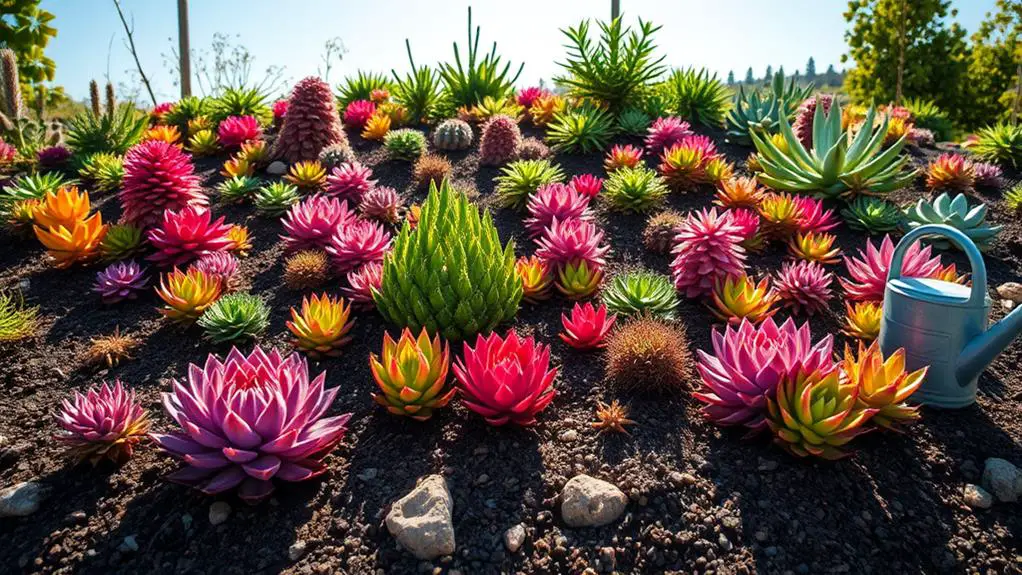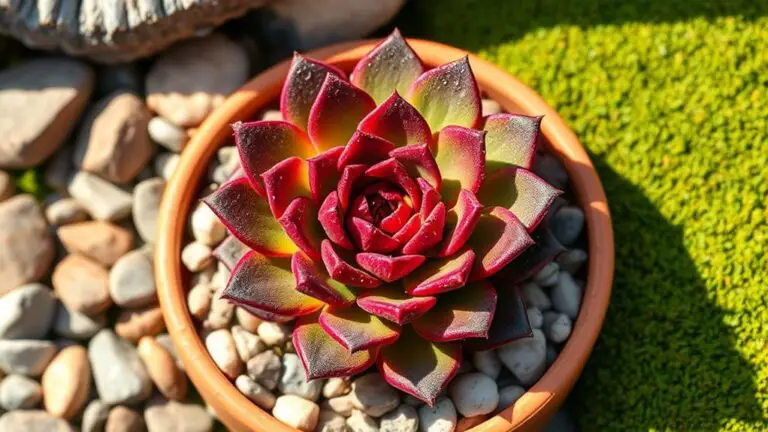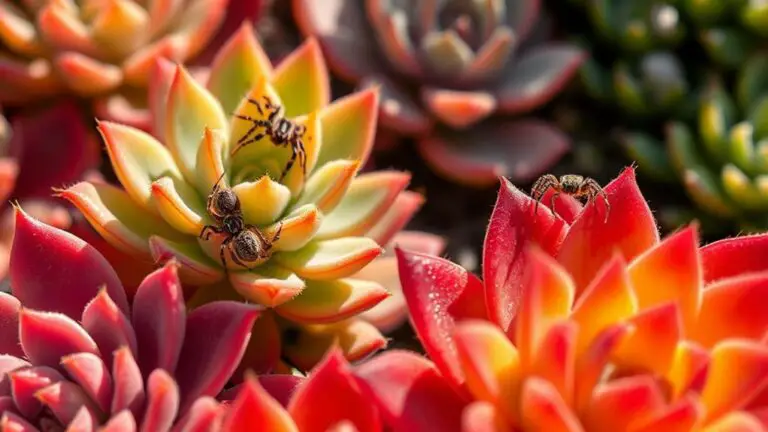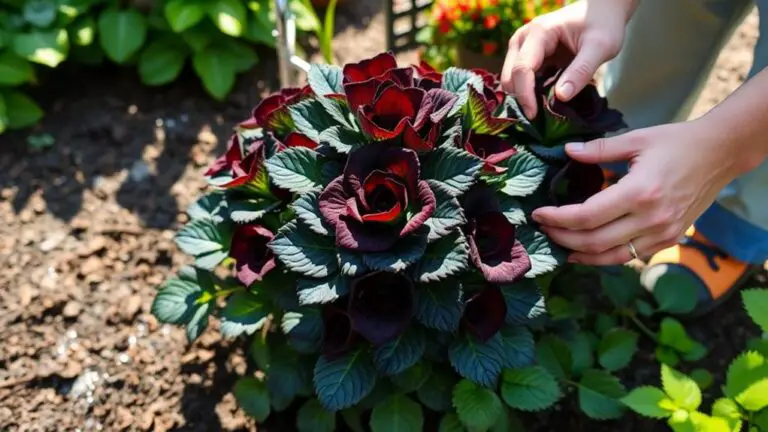7 Key Reminders to Grow Succulents in Full Sun
When you're aiming to grow succulents in full sun, it's essential to keep a few key reminders in mind to guarantee your plants thrive. Start by selecting sun-loving varieties and gradually acclimating them to direct sunlight. You'll need to monitor their response closely and adjust watering practices, making certain the soil is dry before watering again. Proper planting methods, such as using well-draining soil and containers with drainage holes, are also critical. But there's more to take into account, like the age and size of your succulents, and how often you should repot them. Curious about the other essentials?
Choose the Right Succulents
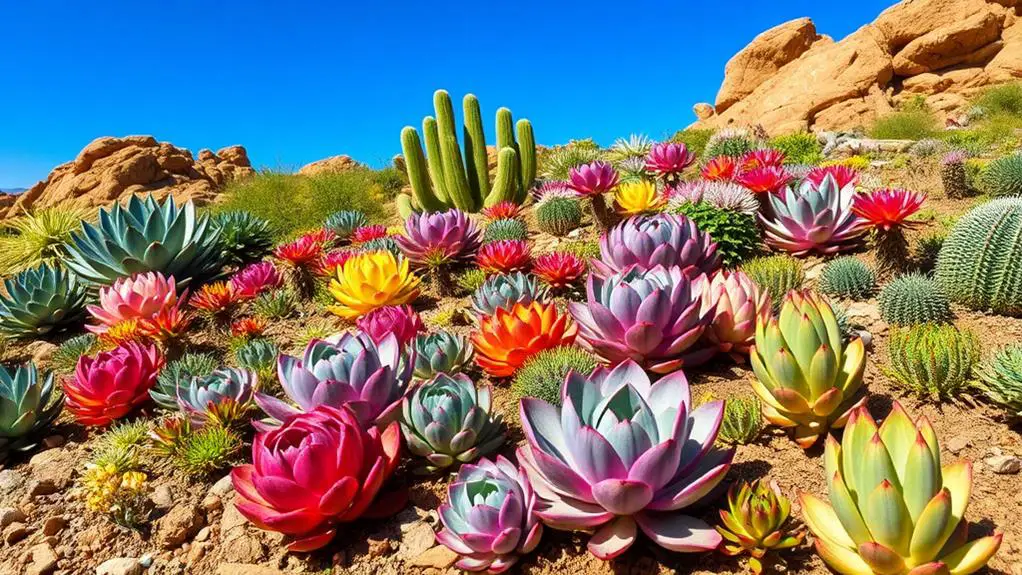
When growing succulents in full sun, it's vital to choose the right varieties. Not all succulents can handle the intense sunlight and heat. For best results, go for sun-loving types like Agaves, Senecio Blue Chalk Sticks, and Echeverias. These varieties are well-suited for hot temperatures and thrive under full sun exposure.
Before planting, do some research on the specific succulent types you're considering. While cacti generally enjoy warm conditions, some succulents like Aeonium might struggle in the summer heat. Choosing the right plants is key to their survival and growth.
Another important care tip is to select local varieties that are adapted to your regional climate. These plants will have a better chance of thriving in your garden.
Additionally, it's important to introduce your succulents gradually to direct sunlight. Start with a few hours each day, increasing the exposure over 2-3 weeks to prevent sunburn.
Consider Age and Size
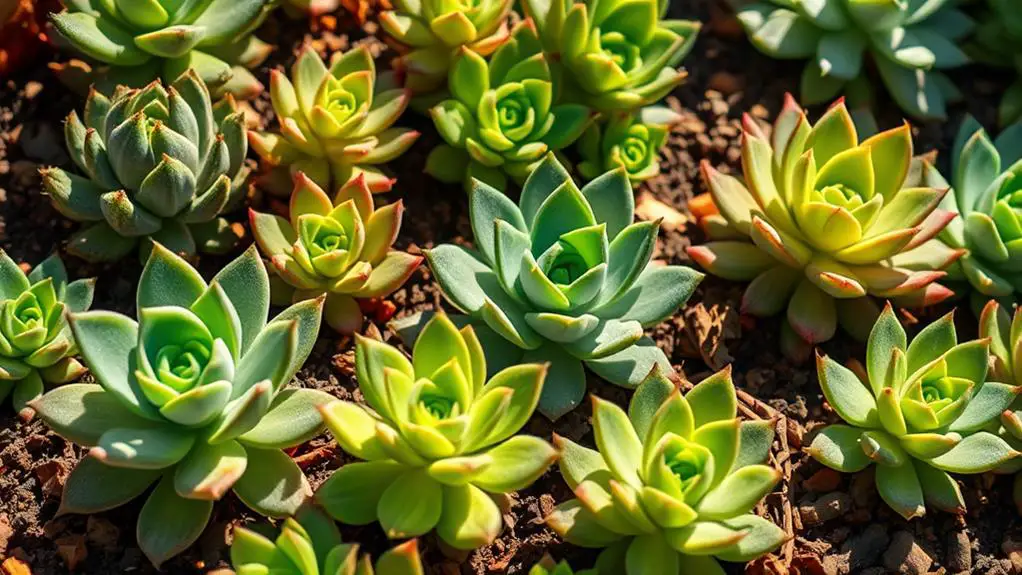
Considering the age and size of your succulents is essential for their successful growth in full sun. Larger succulents typically have deeper root systems, which help them tolerate extreme heat and full sun conditions better than younger or smaller succulents.
If you're working with young or smaller succulents, you'll need to be more attentive to their needs, especially during high temperatures.
Younger succulents are particularly vulnerable to sunburn when exposed to direct sunlight, especially in harsh conditions like 90-degree weather. To prevent this, you should follow an acclimatization process. Start by placing them in a shady spot and gradually increase their exposure to full sun over a period of 2-3 weeks. This gradual adjustment helps minimize shock and prevent damage.
Newly planted succulents are also at higher risk of sunburn. Ensuring they get used to full sun exposure slowly will increase their chances of survival.
Mature succulents, on the other hand, are generally more resilient due to their well-established root systems. By considering the age and size of your succulents, you can provide the care they need to thrive in full sun.
This thoughtful approach will lead to healthier, more vibrant plants.
Opt for Proper Planting Methods

When planting succulents in full sun, you need to think about the right methods.
Use well-draining soil to stop excess moisture, which can cause root rot.
Whether you plant in the ground or containers, make sure containers have drainage holes for water to escape, and watch out for heat stress on super hot days.
Ground vs. Containers
Planting succulents in the ground generally offers a cooler and more stable environment compared to containers, which can heat up quickly under full sun. Ground planting helps maintain cooler soil temperatures and retains moisture more effectively. This reduces the risk of overheating and allows for healthier root systems in your succulents.
When your plants are in the ground, they're less likely to suffer from heat stress, making it an excellent option for full sun exposure.
However, if you prefer container planting, be aware that containers can heat up fast under the sun. This can lead to your succulents drying out or even getting sunburned. To prevent this, you might need to provide temporary shade during extreme heat.
Regularly check your container plants for signs of heat stress, such as wilting or scorched leaves.
Regardless of whether you choose ground planting or container planting, always use well-draining soil. This is vital to prevent waterlogging and root rot, especially when succulents are exposed to full sun.
Keep an eye on your plants, and you'll be able to enjoy their beauty and resilience all summer long.
Soil and Drainage
A essential factor in growing healthy succulents in full sun is using well-draining soil. You'll want to use soil specifically designed for succulents. This usually means mixing potting soil with sand, pumice, or perlite. These additions help improve drainage and prevent waterlogged soil, which can lead to root rot.
Make sure your pots have drainage holes. These holes allow excess water to escape, which is significant because waterlogged soil can suffocate roots and encourage bacterial growth. If you're just starting out, terra-cotta pots are a great choice. They dry out faster and give better air circulation to the roots, helping to reduce the risk of overwatering.
Avoid using heavy clay or compact soil. These types of soil retain too much moisture and can hinder root aeration, creating unhealthy conditions for your succulents.
For the best growth, consider repotting your succulents every 1-2 years. This refreshes the soil nutrients and maintains a healthy root system.
Gradual Sun Exposure
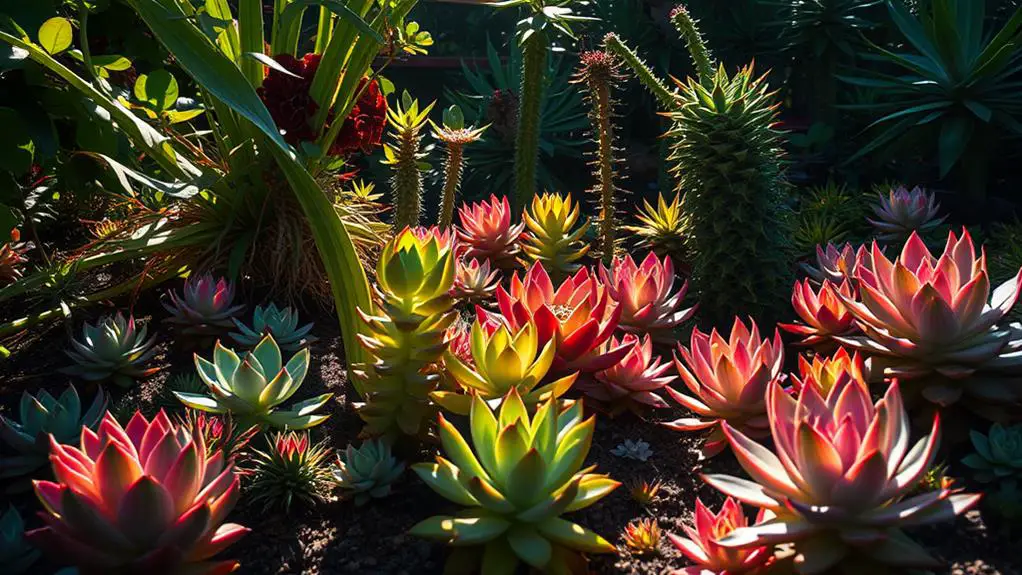
When introducing your succulents to full sun, start by placing them in a shaded area and gradually increase their exposure over 2-3 weeks.
This slow adjustment helps prevent shock and sunburn, ensuring your plants stay healthy.
Keep a close eye on them for any signs of distress, like wilting or discoloration, and be ready to adjust their exposure if needed.
Start in Shade
Introducing succulents to direct sunlight too quickly can lead to sunburn and stress, especially for younger or smaller plants. To avoid this, start in shade first. Place new succulents in a shaded area for 2-3 weeks. This helps them acclimate to their new environment.
Gradually introduce them to more sunlight over several weeks. Doing this prevents shock and sunburn, which can harm your plants.
It's important to monitor the plants closely during this time. Watch for signs of distress like wilting or discoloration. If you see these signs, provide immediate shade to protect them. Using sheer cloths or temporary shade solutions can be very helpful, especially during peak sunlight hours or in extremely hot conditions.
After acclimating your succulents, make sure they receive about six hours of sunlight daily for ideal growth and health. This approach allows them to adapt to sun exposure without extra stress.
Increase Sun Gradually
To help your succulents adapt to full sun, you'll need to increase their exposure gradually. Start by placing your new or sensitive succulents in a shaded area. This helps them get used to being outdoors without the shock of direct sunlight right away.
Over the next 2-3 weeks, slowly increase the amount of direct sunlight they receive each day. This gradual approach prevents sunburn and other damage, allowing your succulents to grow strong and healthy.
You can begin by moving them to a spot that gets a few hours of morning sun, then gradually increase their time in the light. If you don't increase sun exposure gradually, your plants might get sunburned, leading to wilting or leaf discoloration.
As you grow them outdoors, it's essential to monitor plants for any signs of distress. Adjusting the watering schedule is also important since full sun will dry out the soil faster.
Temporary shade solutions like sheer cloths or umbrellas can be beneficial during this changeover. With careful monitoring and gradual exposure, your succulents can thrive in full sun without extra care.
Monitor Plant Response
As you start increasing your succulents' exposure to sunlight, it's vital to keep a close eye on how they're responding. Gradually introduce your plants to full sun by starting them in partial shade for 2-3 weeks. This helps reduce the risk of sunburn and shock.
As you monitor their progress, watch for signs of distress. Wilting and discoloration are clear indicators that your succulent may be getting too much direct sunlight.
Increase their exposure slowly, allowing them to acclimate to the brighter light. If you notice any signs of distress, such as wilting or leaves turning brown, it's time to take action. Use temporary shade solutions, like sheer cloths, to protect your succulents during the peak sunlight hours, especially if the weather is extremely hot.
Don't forget to rotate your succulents regularly. This guarantees even exposure to sunlight and prevents them from leaning towards the light source, which can cause uneven growth.
Monitor for Stress Signs
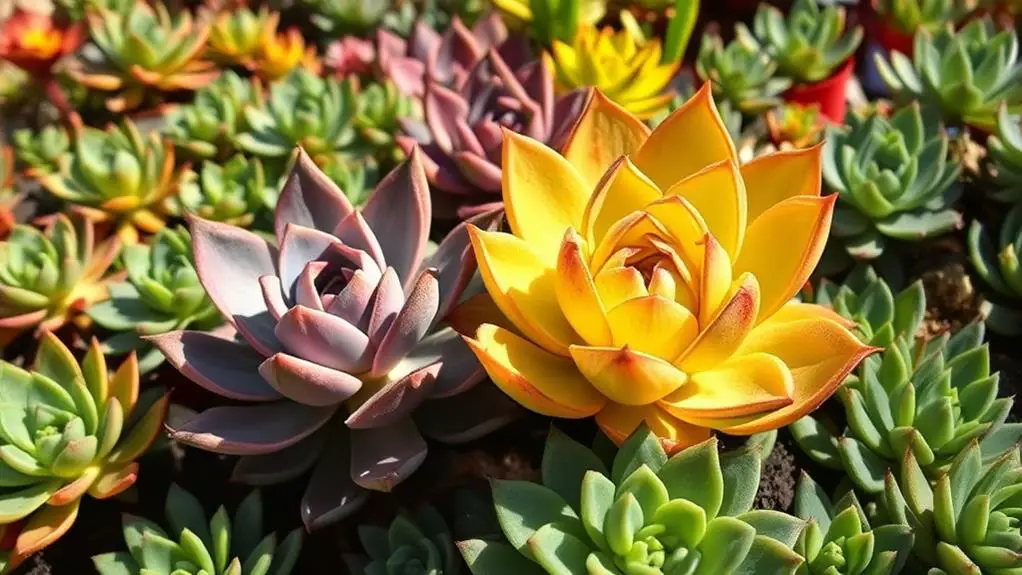
Keeping a close eye on your succulents for stress signs is essential when they're exposed to full sun. Regularly monitor for stress signs like sunburned leaves, dehydration, or wilting.
Sunburned leaves can show up as bleached patches or browning edges, indicating too much direct sunlight too quickly. If you notice these signs, it's important to act fast.
Dehydration is another critical sign to watch for. Look for shriveling or drooping leaves, which suggest your plant might be suffering from excessive heat or inadequate watering.
Adjust your watering routine based on these observations. However, be cautious and verify the soil is dry before watering again to prevent root rot.
Early detection of stress signs allows you to intervene promptly. If your succulent shows signs of stress, you might need to relocate the plant to a shadier spot or use shade cloths to reduce sun exposure.
These steps can help protect your plant and give it time to recover.
Adjust Watering Practices
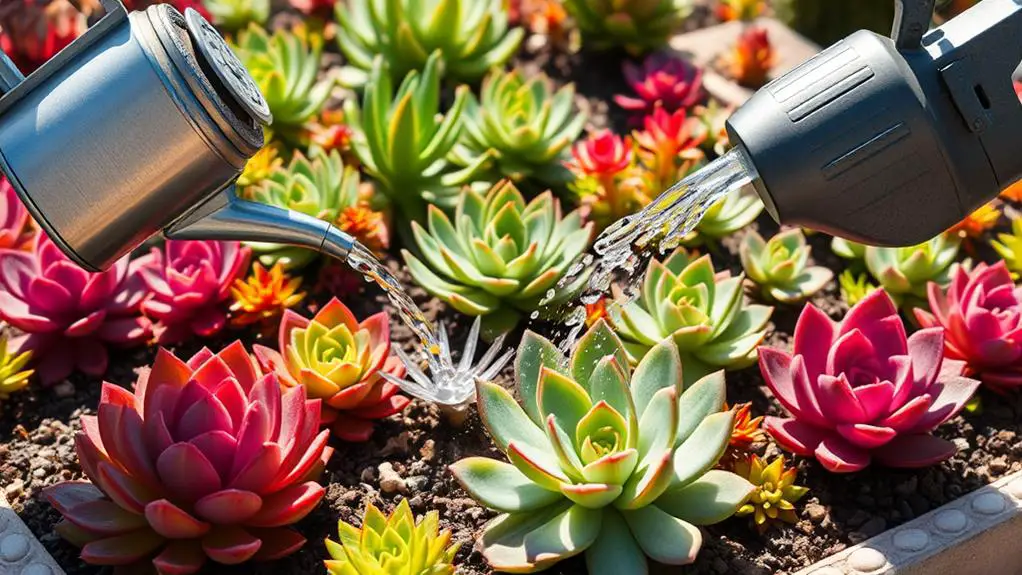
When adjusting your watering practices for succulents in full sun, it's crucial to strike a balance between hydration and preventing root rot. Start by only watering when the top 1.25 inches of soil is dry to the touch. In full sun exposure, your soil mix will dry out faster, so keep an eye on it.
Use the "soak and dry" method: thoroughly soak the soil until water drains from the bottom, then let it dry completely before watering again.
During hot weather, you'll need to monitor your succulents more closely. They may need more frequent watering, but always make sure the soil dries out fully to avoid overwatering.
Pay extra attention to young or newly planted succulents since they can dehydrate quickly in full sun. Check their moisture levels more often to keep them healthy.
As seasons change, adjust your watering schedule accordingly. Succulents typically need more water during their active growth phases in spring and summer.
Remember, each succulent might've slightly different needs, so observe and adjust as necessary. With these succulent care tips, you can maintain a thriving garden even in full sun.
Keep these practices in mind, and your succulents will flourish!
Ensure Well-Draining Soil
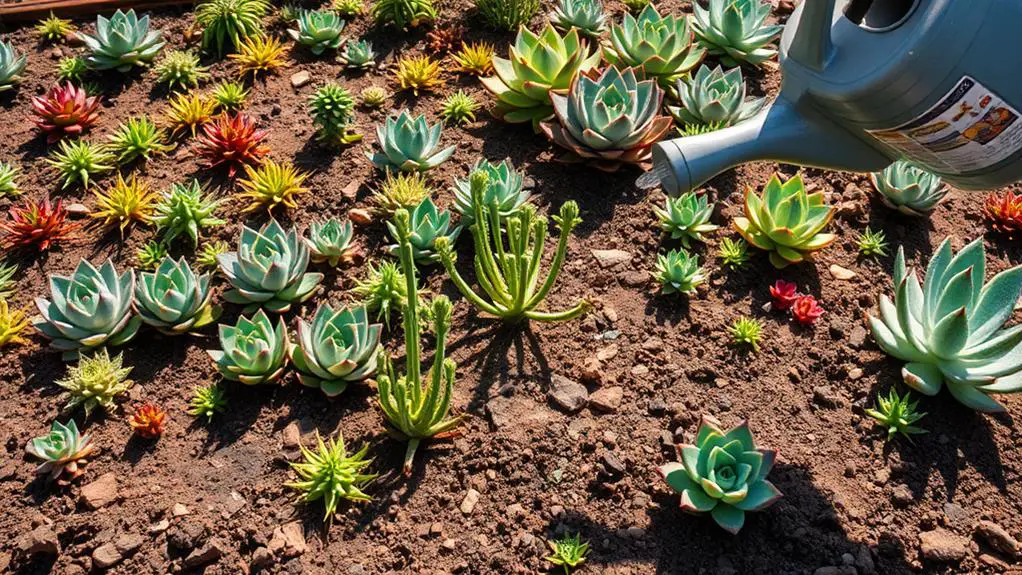
Balancing your watering practices is just one part of keeping succulents healthy in full sun. Confirming well-draining soil is vital to prevent waterlogging, which can cause root rot and bacterial infections.
A good soil mix for succulents includes equal parts soil, sand, peat moss, and perlite. This combination guarantees proper drainage and aeration, which are fundamental for succulent growth.
Regular potting soil doesn't cut it for succulents. You need sandy or porous mixes designed specifically for them. Terra-cotta pots are an excellent choice because they let excess moisture evaporate faster than plastic pots, keeping your plants' roots healthy and happy.
Remember, proper drainage is key.
Repotting your succulents every 1-2 years with fresh, well-draining soil is also important. This practice helps maintain nutrient levels and creates ideal growing conditions.
When you repot, be gentle with the roots and make sure to use a soil mix that promotes drainage.
Frequently Asked Questions
Is It OK to Put Succulents in Direct Sunlight?
Yes, you can put succulents in direct sunlight, but introduce them gradually over 2-3 weeks to prevent sunburn. Older succulents handle full sun better. Watch for signs of distress like wilting or discoloration.
How Often Do You Water Succulents in Full Sun?
Water succulents in full sun when the top half-inch of soil feels dry. Check daily during extreme heat. Use the "soak and dry" method, ensuring complete drainage. Adjust watering frequency based on seasons and plant growth.
How Do I Protect My Succulents From Hot Sun?
To protect your succulents from hot sun, gradually introduce them to full sun. Use temporary shade solutions during extreme heat and guarantee they're in well-draining soil. Regularly monitor for stress signs and relocate if needed.
How Do Succulents Acclimate to Full Sun?
To acclimate your succulents to full sun, gradually increase their sunlight exposure over 2-3 weeks. Start with partial shade, then slowly move them to more light. Watch for signs of distress and adjust as needed.
Conclusion
You've got this! By choosing the right succulents, considering their age and size, and planting them properly, you're on the right path. Gradually expose them to sunlight, monitor for stress, and adjust your watering practices as needed. Remember to use well-draining soil to keep them happy. With these tips, your sun-loving succulents will thrive. Stay patient and keep an eye on them, and you'll enjoy a vibrant, healthy garden in no time!

